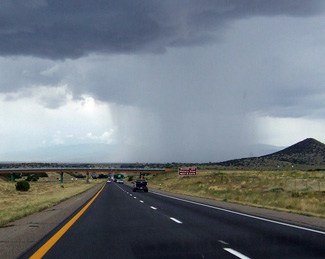
On Interstate 25 (Photo by joebeone/flickr.com
A decision must be made to find funding alternatives or determine which activities and services the state will cut
The bad news about state finances comes so often, it’s hard to pay attention sometimes. The latest bad news comes from the Department of Transportation, which is warning local governments to expect cuts in money for local road projects because of declines in the state road and local government road funds.
In a letter sent to local government road fund program participants, the department asks the participants to review projects to determine which can be downsized or postponed. School bus routes, city streets and equipment are all on the chopping block.
The bad news about the road fund should come as no surprise. Policy makers have been predicting a precipitous drop in federal and state road dollars for two years.
Road construction is supported in large part by taxes on gasoline and other fuels, and fuel consumption was already on the decline before the recession hit. The popularity of hybrid vehicles is just one sign of the strong movement to greater energy efficiency throughout our lives.

John Arthur Smith
Further, both the state and federal tax rates have been unchanged for decades, and are not keeping pace with inflation. The real value of the funds is dropping at the same time the cost of construction is climbing.
Some states, like New Mexico, have exacerbated the problem by using the road fund stream to pay the debt service on road construction bonds. New Mexico has total outstanding road debt of $1.59 billion, with debt service payments estimated at $166 million for the next budget year. Unless the flow of federal highway transportation fund improves, New Mexico will not have enough money to pay the debt and cover its road maintenance.
And if the flow of federal dollars increases, New Mexico might not have enough money in the state road fund to meet federal matching requirements.

Already in trouble
New Mexico road construction plans are already in trouble. Governor Richardson’s Investment Partnership (GRIP) — 2003 legislation that authorized the issuance of $1.585 billion in road construction bonds over a six-year period — started out short because of inaccurate cost estimates and construction cost inflation. Despite efforts to shore up the program with state general fund monies and federal stimulus funds, the program is still underfunded by $420 million, threatening the completion of all outstanding GRIP projects.
The state is also overcommitted on road maintenance. The number of highway miles in the state has increased significantly over the last decade, and the department is falling behind on maintenance. The cost of chip sealing, which prolongs the life of the road, has doubled in the last 10 years, and the department has been forced to switch from a five- to six-year cycle for sealing roads to a nine- to 10-year cycle.
The switch means that not only will New Mexico drivers be bumping over more deteriorating roads, but some roads will fail early and force the state into much more costly replacement.
It’s important to take a clear-headed look at the state of transportation funding in New Mexico and acknowledge that the current tax structure is not sufficient to support New Mexico’s road needs. A decision must be made to find funding alternatives or determine which activities and services the state will cut.
Smith has represented Senate District 35, which includes parts of Hidalgo, Luna and Sierra counties, since 1989. He currently is vice chairman of the Legislative Finance Committee and chairman of the Senate Finance Committee.
